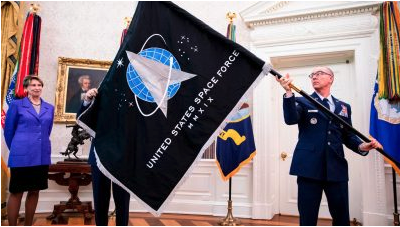By Peter Garretson
What’s the proper place of America’s newest military branch?
The US Air Force, Army, and Navy are currently debating the importance of integrating the US Space Force into the structure of the armed forces.
But the current debate belies a crucial point. For decades, those same services have starved space of required resources and talent. Making up for this deficit, and responding to the new directives of the president and Congress, will consume most of the Space Force’s efforts for years. The service is going to start small and undermanned.
If the other branches of the military truly value integration, they need to make up the difference. In turn, the aggressiveness with which the various services and Combatant Commands (COCOMs) pony up the necessary resources will determine the tenor of future habitual relationships.
It will also dictate with whom the Space Force will be a willing partner — and with whom a grudging one.
What would that mean, in practice?
First, those services and COCOMs that value integration will invest in the Space Force with their people. They will be aggressive about sending their own best and brightest rising leaders as liaisons to the Space Force and Space Command intelligence, planning and operations staffs. That’s a bill of at least five mid-grade officers to each.
Second, the terrestrial services will provide opportunities and incentives for the Space Force to invest in them in turn. They will identify the opportunities for liaison positions, knowing that, for the near-term, this will be an “ask,” and that previously occupied positions may go unfilled. But they will clearly identify who and how many officers they would like to send through Space Force professional schools. And they will allocate funding for those positions.
Third, integration cuts both ways. It isn’t going to simply be just the Space Force supporting the other services. The Army, Navy, and Air Force all need to come to the table with ideas of how they can support space control missions, like counter-space and space denial.
This is equally true for SOCOM, CYBERCOM, STRATCOM, INDOPACOM and EUCOM.
They must take the lead and create opportunities for their operators, planners, intelligence specialists, and engineers to mingle with their Space Force counterparts to explore combined arms and cross-domain solutions in an exploratory format.
These activities may be especially hard for the Air Force, which has what are perhaps the strongest attitudes about collaboration and integration. But the Air Force cannot just assume that it will dictate terms to the Space Force, like it did to Air Force Space Command in earlier years.
The Space Force may have priorities other than serving Air Force concerns. Air Force efforts to make the Space Force pay the lion’s share of the integration bill, or to manipulate the new service, will only hasten the Space Force’s decoupling.
Finally, if Congress values integration, there are four steps it needs to take legislatively in order to promote a conducive, collaborative atmosphere.
First, it must give the Space Force a reserve and guard component, which will give the new military branch access to the broad pool of human capital required to integrate with the other services effectively.
Second, it must establish an independent legislative liaison, public affairs, financial management, and intelligence functions within the Space Force, so that the service has a truly independent voice on joint matters.
Third, it should establish a military attaché corps to facilitate integration with allied nations and advance US interests in space through international cooperation and dialogue.
Finally, to ensure that the Space Force is adequately resourced for both space superiority and supporting terrestrial services, Congress needs to establish a working capital fund (similar to the Transportation Working Capital Fund) which will give the Army, Navy and Air Force the say they deserve in space support services and systems.
The Space Force is already on a path to be an excellent partner in the Joint Force. By taking these steps, Congress and the rest of the military can help to make the Space Force’s contribution even better.
Peter Garretson is an independent strategy consultant who focuses on space and defense, a senior fellow in Defense Studies with the American Foreign Policy Council, and co-director of the AFPC Space Policy Initiative. He was previously the director of Air University’s Space Horizons Task Force, America’s think tank for space, and was deputy director of America’s premier space strategy program, the Schriever Scholars. He is the author of Scramble for the Skies: The Great Power Competition to Control the Resources of Outer Space.




